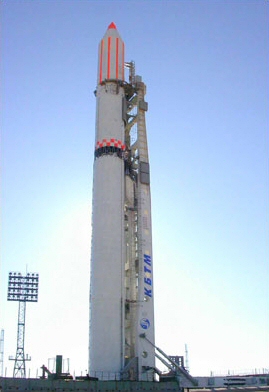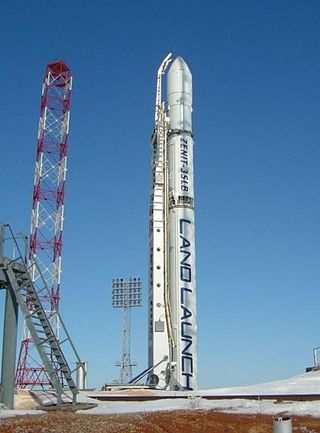
Sea Launch was a multinational—Norway, Russia, Ukraine, United States—spacecraft launch company founded in 1995 that provided orbital launch services from 1999 to 2014. The company used a mobile maritime launch platform for equatorial launches of commercial payloads on specialized Zenit-3SL rockets from a former mobile/floating oil drilling rig renamed Odyssey.

Zenit is a family of space launch vehicles designed by the Yuzhnoye Design Bureau in Dnipro, Ukraine, which was then part of the Soviet Union. Zenit was originally built in the 1980s for two purposes: as a liquid rocket booster for the Energia rocket and, equipped with a second stage, as a stand-alone middle-weight launcher with a payload greater than the 7 tonnes of the Soyuz but smaller than the 20 tonnes payload of the Proton. The last rocket family developed in the USSR, the Zenit was intended as an eventual replacement for the dated Soyuz and Proton families, and it would employ propellants which were safer and less toxic than the Proton's nitrogen tetroxide/UDMH mix. Zenit was planned to take over crewed spaceship launches from Soyuz, but these plans were abandoned after the dissolution of the Soviet Union in 1991.

Commercial use of space is the provision of goods or services of commercial value by using equipment sent into Earth orbit or outer space. This phenomenon – aka Space Economy – is accelerating cross-sector innovation processes combining the most advanced space and digital technologies to develop a broad portfolio of space-based services. The use of space technologies and of the data they collect, combined with the most advanced enabling digital technologies is generating a multitude of business opportunities that include the development of new products and services all the way to the creation of new business models, and the reconfiguration of value networks and relationships between companies. If well leveraged such technology and business opportunities can contribute to the creation of tangible and intangible value, through new forms and sources of revenue, operating efficiency and the start of new projects leading to multidimensional positive impact. Examples of the commercial use of space include satellite navigation, satellite television and commercial satellite imagery. Operators of such services typically contract the manufacturing of satellites and their launch to private or public companies, which form an integral part of the space economy. Some commercial ventures have long-term plans to exploit natural resources originating outside Earth, for example asteroid mining. Space tourism, currently an exceptional activity, could also be an area of future growth, as new businesses strive to reduce the costs and risks of human spaceflight.
MEASAT-3a is a communications satellite which MEASAT Satellite Systems intends to operate in geosynchronous orbit at 91.5 degrees East longitude. It was built by Orbital Sciences Corporation, based on the STAR-2 spacecraft platform.

The year 2011 saw a number of significant events in spaceflight, including the retirement of NASA's Space Shuttle after its final flight in July 2011, and the launch of China's first space station module, Tiangong-1, in September. A total of 84 orbital launches were conducted over the course of the year, of which 78 were successful. Russia, China and the United States conducted the majority of the year's orbital launches, with 35, 19 and 18 launches respectively; 2011 marked the first year that China conducted more successful launches than the United States. Seven crewed missions were launched into orbit during 2011, carrying a total of 28 astronauts to the International Space Station. Additionally, the Zenit-3F and Long March 2F/G carrier rockets made their maiden flights in 2011, while the Delta II Heavy made its last.

An orbital propellant depot is a cache of propellant that is placed in orbit around Earth or another body to allow spacecraft or the transfer stage of the spacecraft to be fueled in space. It is one of the types of space resource depots that have been proposed for enabling infrastructure-based space exploration. Many different depot concepts exist depending on the type of fuel to be supplied, location, or type of depot which may also include a propellant tanker that delivers a single load to a spacecraft at a specified orbital location and then departs. In-space fuel depots are not necessarily located near or at a space station.

The Zenit 3SLB or Zenit-3M is a Ukrainian expendable carrier rocket derived from the Zenit-2SB. It is a member of the Zenit family of rockets, which were designed by the Yuzhnoye Design Office. Produced at Yuzhmash, the rocket is a modified version of the Zenit-3SL, designed to be launched from a conventional launch pad rather than the Sea Launch Ocean Odyssey platform. Most of components of the rocket are produced in Russia.
Intelsat 19 is a geostationary communications satellite operated by Intelsat. It was constructed by Space Systems/Loral, based on the LS-1300 satellite bus. It was successfully launched by Sea Launch using a Zenit-3SL launch vehicle on 1 June 2012 at 05:22:59 UTC. Upon entering service it replaced Intelsat 8 at 166° East Longitude.
Galaxy 11 is an American geostationary communications satellite which is operated by Intelsat. It is located in geostationary orbit at a longitude of 32.8 degrees east, where it serves as a backup to the Intelsat 802 spacecraft. It was originally operated at 99° West and later spent most of its operational life at 91° West, from where it was used to provide communications services to Brazil and North America.
Intelsat 15, also known as IS-15, is a communications satellite owned by Intelsat. Intelsat 15 was built by Orbital Sciences Corporation, on a Star-2.4. It is located at 85° E longitude on the geostationary orbit. It was launched from Baikonur Cosmodrome to a geosynchronous transfer orbit on 30 November 2009 by a Zenit-3SLB launch vehicle. It has 22 active Ku band transponders, plus eight spares. Five of those transponders are owned and operated by SKY Perfect JSAT Group under the name JCSAT-85.

Docking and berthing of spacecraft is the joining of two space vehicles. This connection can be temporary, or partially permanent such as for space station modules.
Space Infrastructure Servicing (SIS) is a spacecraft concept being developed by Canadian aerospace firm MDA to operate as a small-scale in-space refueling depot for communication satellites in geosynchronous orbit.
A Mission Extension Vehicle (MEV) is a type of spacecraft designed to extend the functional lifetime of another spacecraft through on-orbit satellite servicing. They are 2010s-design small-scale in-space satellite-refueling spacecraft first launched in 2019. The MEV spacecraft grew out of a concept proposed in 2011 by ViviSat, a 50/50 joint venture of aerospace firms US Space and Alliant Techsystems (ATK). The joint venture was created in 2010 for the purpose of designing, producing and operating the MEV program.

In 2013, the maiden spaceflight of the Orbital Sciences' Antares launch vehicle, designated A-ONE, took place on 13 April. Orbital Science also launched its first spacecraft, Cygnus, that docked with the International Space Station in late September 2013.

Telstar is the name of various communications satellites. The first two Telstar satellites were experimental and nearly identical. Telstar 1 launched on top of a Thor-Delta rocket on July 10, 1962. It successfully relayed through space the first television pictures, telephone calls, and telegraph images, and provided the first live transatlantic television feed. Telstar 2 was launched May 7, 1963. Telstar 1 and 2—though no longer functional—still orbit the Earth.
Telstar 14R, also known as Estrela do Sul 2 is a commercial communications satellite in the Telstar series built by Space Systems/Loral for Telesat to provide Ku-band communications to South America and the Southern United States. It is a replacement for Telstar 14, whose north solar array failed to open after launch, limiting its mission effectiveness. Telstar 14R experienced the same problem, with its north solar array failing to open too, but is now in service despite that failure.
Telstar 14 or Estrela do Sul 1 is a commercial communications satellite in the Telstar series built by Space Systems/Loral (SS/L) for Telesat to provide Ku-band communications to South America and the Southern United States. Estrela do Sul 1 was launched by Sea Launch using a Zenit-3SL carrier rocket on 11 Jan 2004 for geosynchronous orbit at 63 degrees west.
AMOS-4 is an Israeli commercial communications satellite, operated by Spacecom Satellite Communications, Tel Aviv-based, part of the AMOS series of satellites.

The following is a timeline of important events in the history of private spaceflight, including important technical as well as legislative and political advances. Though the industry has its origins in the early 1960s, soon after the beginning of the Space Age, private companies did not begin conducting launches into space until the 1980s, and it was not until the 21st century that multiple companies began privately developing and operating launch vehicles and spacecraft in earnest.











